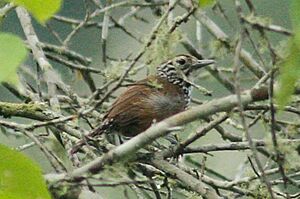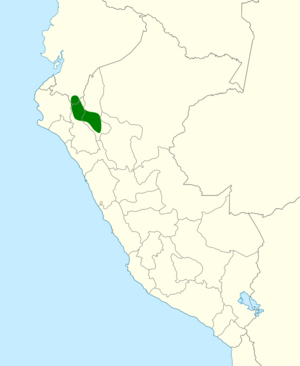Speckle-breasted wren facts for kids
Quick facts for kids Speckle-breasted wren |
|
|---|---|
 |
|
| photo captured in Ecuador | |
| Conservation status | |
| Scientific classification | |
| Genus: |
Pheugopedius
|
| Species: |
sclateri
|
 |
|
| Synonyms | |
|
Thryothorus sclateri |
|
The speckle-breasted wren (Pheugopedius sclateri) is a small bird from the Troglodytidae family, also known as wrens. You can find this bird in parts of Colombia, Ecuador, and Peru. It gets its name from the speckled patterns on its chest.
Contents
About the Speckle-breasted Wren
Scientists group living things into categories. This helps us understand how they are related. The speckle-breasted wren has been studied to see how it connects to other wrens.
Some scientists once thought the speckle-breasted wren was the same species as the rufous-breasted wren and the spot-breasted wren. However, they are now seen as different species. They do form a "superspecies," which means they are very closely related.
There are three main types, or subspecies, of the speckle-breasted wren. Different bird groups recognize these subspecies slightly differently:
- P. s. sclateri (also called the Marañon wren)
- P. s. columbianus (also called the Colombian wren)
- P. s. paucimaculatus (also called the speckle-breasted wren)
Some organizations, like BirdLife International, even consider these three types as completely separate species.
What Does It Look Like?
The speckle-breasted wren is a small bird, about the size of your hand. Its exact size and colors can be a bit different depending on which subspecies it is.
Marañon Wren (P. s. sclateri)
This type is about 14.5 to 15.5 centimeters (5.7 to 6.1 inches) long. It weighs around 20 grams (0.7 ounces).
Adults have a reddish-brown top of the head. Their back is medium brown. Their tail has gray and dull black stripes. They have a thin white stripe above their eye and a dark stripe through their eye. The sides of their face and neck look speckled with black and white.
Their chest and belly have fine black and white stripes. These stripes become less clear towards their lower belly. The sides of their body also have a light brown color. Young birds look similar but their belly stripes don't go as far down.
Colombian Wren (P. s. columbianus)
This subspecies is a bit smaller, about 13 to 14 centimeters (5.1 to 5.5 inches) long.
Adults have a uniform brown color on their upper body. Their head has a reddish tint. Their tails have wide dark stripes. They also have a thin white stripe above their eye. Their face and most of their underside are white with black stripes and spots. The sides of their body are a dark, light brown.
Speckle-breasted Wren (P. s. paucimaculatus)
This type is 13.5 to 15.5 centimeters (5.3 to 6.1 inches) long. Males are a bit heavier, averaging 12.7 grams (0.45 ounces), while females average 10 grams (0.35 ounces).
Adults have a uniform brown upper body. Their tail has black stripes. They have a thin white stripe above their eye. Their cheeks are speckled with black and white. Most of their underside is whitish. Their chest is heavily speckled with black, and the sides of their body are reddish-brown. Young birds look similar but their chest is not as heavily speckled.
Where Do They Live?
Each subspecies of the speckle-breasted wren lives in slightly different areas and habitats.
- Marañon Wren (P. s. sclateri): You can find this bird in the Marañon River area. This is in the very south of Ecuador and northern Peru. It likes the dense plants under dry forests, up to about 1,600 meters (5,200 feet) high.
- Colombian Wren (P. s. columbianus): This subspecies lives in Colombia. It is found on the western slopes of the Central and Eastern Andes mountains. It prefers the thick plants at the edges of forests and in open woodlands. It lives at elevations between 1,300 and 2,000 meters (4,300 and 6,600 feet).
- Speckle-breasted Wren (P. s. paucimaculatus): This type lives from Ecuador's Manabí Province south into Peru's Department of Piura. It lives inside and at the edges of forests that lose their leaves in certain seasons. It especially likes areas with lots of dense plants underneath. It can be found from lowlands up to about 1,600 meters (5,200 feet) in Ecuador and up to 2,000 meters (6,600 feet) in Peru.
Behavior
Feeding
The speckle-breasted wren (P. s. paucimaculatus) is known to eat insects. Scientists believe the other two subspecies also mostly or entirely eat insects.
These wrens usually look for food in the plants close to the ground. Sometimes, they might go a bit higher into the trees. They are often seen in pairs. They also sometimes join groups of different bird species that are foraging together. This helps them find more food and stay safe.
Reproduction
Scientists have studied how the speckle-breasted wren (P. s. paucimaculatus) reproduces. Its breeding season seems to be from April to September. This is based on when active nests were seen, when adults were carrying food, and when young birds had just left the nest.
One nest that was found was shaped like a ball. It was made from sticks, vines, leaves, and moss. This nest was on the ground and held four eggs.
Vocalization
The songs of the three subspecies of speckle-breasted wren sound very similar. Both male and female birds sing "a series of fast, repeated phrases." You can listen to an example of their song here: [1].
Their call is described as "a musical rising trill." You can hear an example of their call here: [2].
Conservation Status
The IUCN (International Union for Conservation of Nature) has looked at each subspecies of the speckle-breasted wren. They have all been listed as "Least Concern." This means they are not currently in danger of disappearing.
All three subspecies have relatively small areas where they live. The Marañon wren (P. s. sclateri) and the speckle-breasted wren (P. s. paucimaculatus) are quite common. They also live in several protected areas. This helps ensure they have enough of their preferred habitats.
However, the number of Colombian wrens (P. s. columbianus) is thought to be decreasing. This is because their habitat is being broken up and destroyed.


